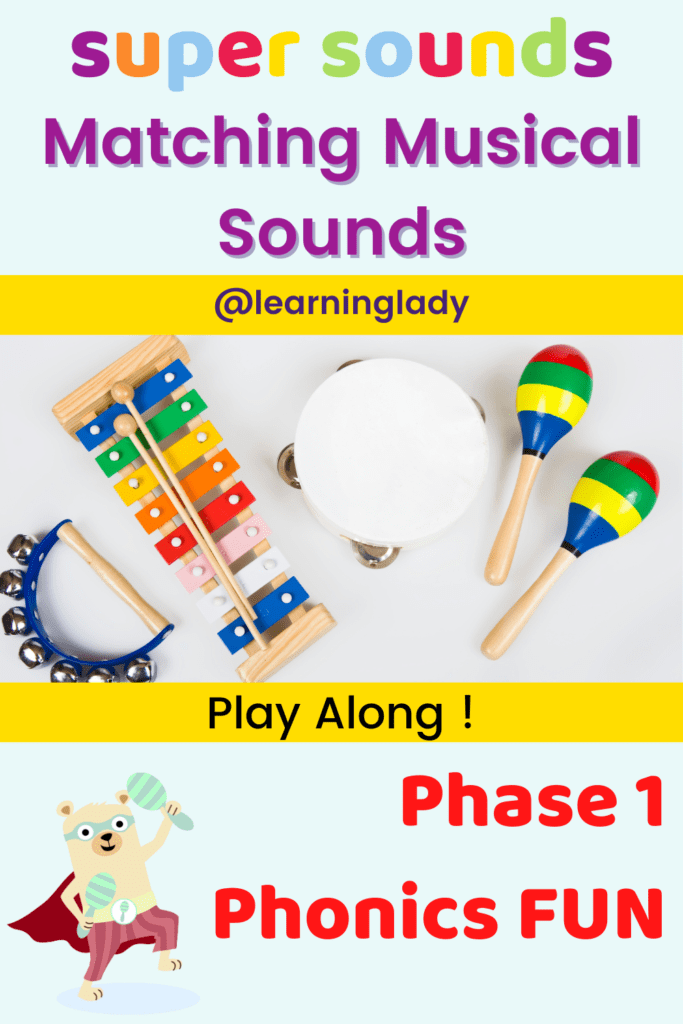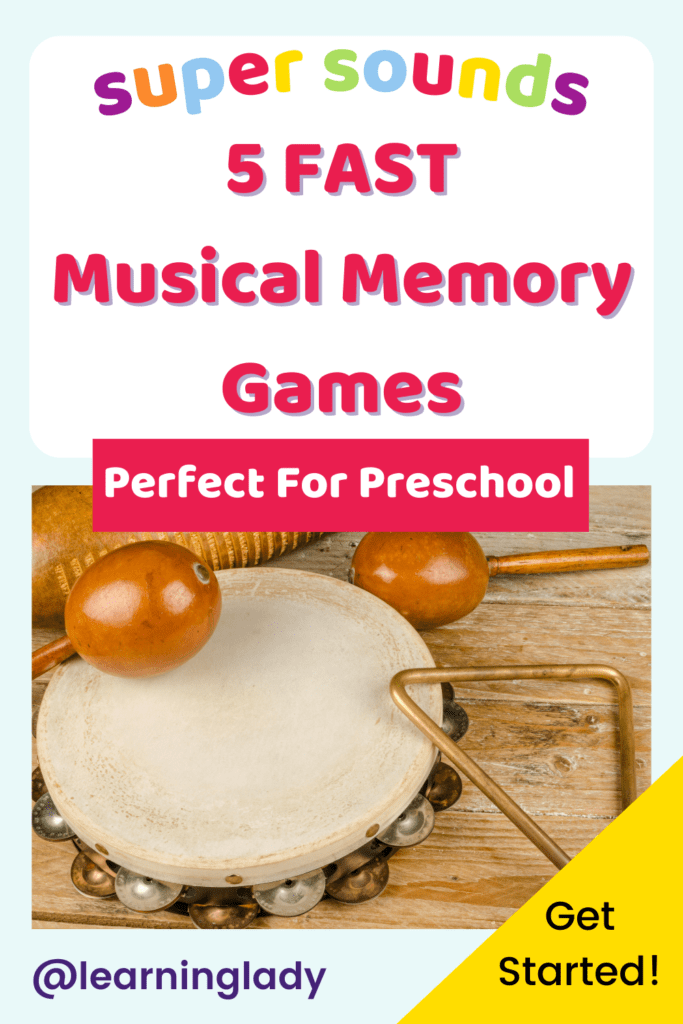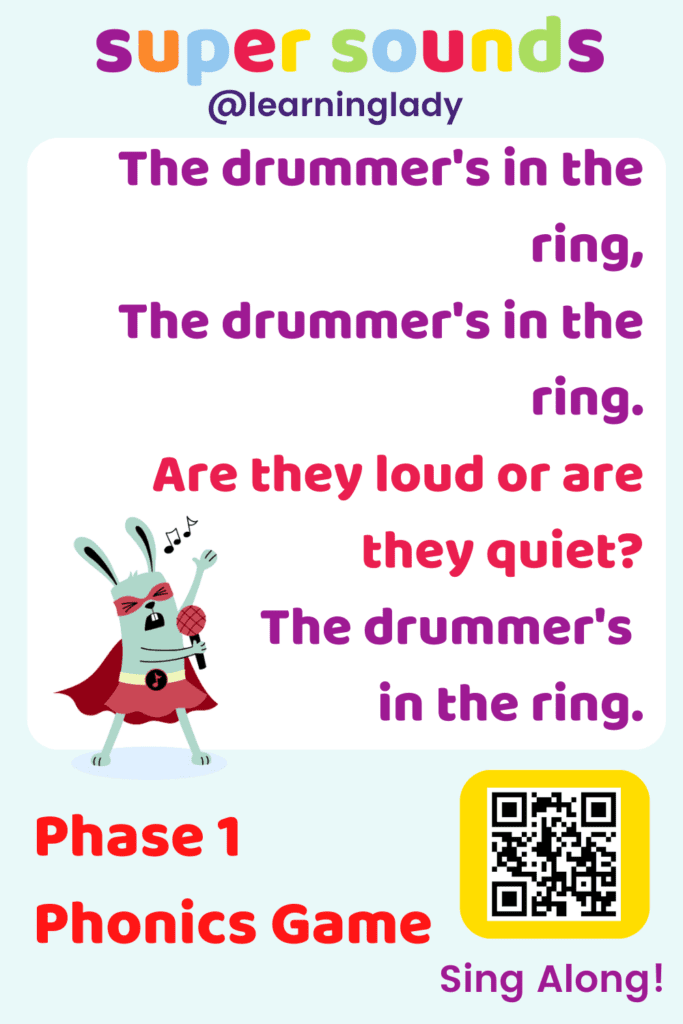Are you new to phase 1 phonics listening games? Do you just need some inspiration for using musical instruments with preschoolers? This post is here to help! Here are 5 new, super simple phase 1 phonics ideas that your children will love, and you’ll want to play for years to come!
Engaging Adi in preschool listening games
Preschoolers love playing preschool listening games with musical instruments, and Adi was no different. He was a shy little boy. In many cases he lacked confidence and hated being put ‘on the spot’ during group times. He always seemed to sit on the edge of activities.
I made a conscious effort to involve Adi in our music sessions, not least because the pressure was off. The emphasis was on everyone joining in together.
This is the story of how Adi became a musician, and learnt some critical prephonic skills too!

Why Phase 1 Phonics activities using instruments are important
Talking about sounds builds vocabulary
During our Phase 1 Phonics activities we were not only matching the instruments to their names, but adapting sounds to match descriptive words too. Building categories of words in this way is so important for developing vocabulary alongside key listening and attention skills.
Adi loved to bang the drum loudly and shake the maracas quickly! He was new to English, so although he wasn’t able to say the names of the instruments or the sounds he was making, Adi was beginning to understand the meaning of new words by copying and repeating them.

With heaps of adult modelling and continued repetition, all of the children started to use the new words too. It particularly helped to add a few new instruments at a time, rather than providing an overwhelming selection to remember all in one go.
How musical activities prepared Adi for reading
Phase 1 Phonics or ‘prephonics’, perfectly lays the foundations for learning in Phonics later. As Phonics is a sounds based system, activities using musical instruments can be super successful for preparing our preschoolers. By incorporating games with symbols, pictures or photos matched to instruments, children like Adi build an awareness of the relationship between a real object and an abstract sound.
We can also challenge our preschoolers to match how they play an instrument with a simple visual symbol, like a colour or an action.
Lots of copying and repetition are needed for developing this understanding. Playing the same musical activities, over and over again, is central to building this symbolic understanding.

Building better brains : Musical Memory Training
Adi had a lot to remember during our musical phonics phase 1 game sessions. His brain was whirring to remember:

- The names of the instuments
- The words to describe how the instrument should be played
- The song words
- The tune of the songs
- The instructions of how to play
- Whose turn it was in the game
The amount we expect children to remember in a short musical activity is phenomenal ! A great reason for playing the same games, with everybody joining in, on repeat!
This simple brain training for building auditory memory is essential for all kinds of learning success, particularly reading and writing. After all, if preschoolers are unable to recall musical patterns or remember song words in order, how will they ever be able to remember what they’ve just been blending or the sentence they’re trying to write.
Inspiration for NEW musical games!
Developing vocabulary, symbolic representation and building auditory memory don’t happen overnight. Adi and his friends needed lots of encouragement to join in and repeat our letters and sounds phase 1 musical activities, which achieved amazing success overtime.
5 FUN Phase 1 Phonics listening games to play with instruments
Here are the 5 favourite musical games that Adi and his friends enjoyed playing again and again. They’re all taken from the Super Sounds Book which includes a complete musical extravaganza for developing pre-phonic skills with 2,3 and 4-year-olds.
Phase 1 Phonics listening games 1 : Favourite Sounds
A no-prep game for preschoolers which is super effective in teaching the names of instruments and developing choice-making.

What you need
A selection of familiar musical instruments placed in the centre of the space, enough for 1 per child. These could be real or homemade sound makers.
A bag containing the children’s names/names with photos.
How to play
Take first steps to reading music and words with this super simple sounds sequencing game. We introduced simple sound sequences using only a few instruments first, with photos of the instruments to make the sequences. Eventually, we created laminated cards with velcro so the children could make up their own compositions and make real music. perfect training for reading from left to right too!
Phase 1 Phonics listening games 3: The Drummer's in the ring
This game helped Adi and his friends to hear the similarities and differences between fast and slow, loud and quiet sounds. It tuned their little ears ready for hearing similarities and differences in letter sounds in school. The children loved being in charge of playing the drum in different ways, the perfect meaningful opportunity for modelling descriptive language too!
What you need
A drum placed in the centre of the space
Children’s names / names with photos, handwritten or printed. These should be placed face down around the drum.

How to play
- Explain that the children are going to take it in turns the be the drummer. Each child can choose to play the drum loudly or quietly.
- Model playing the drum in different ways, modelling the language to describe your playing using a full sentence.
- “I can play the drum loudly”, “I can play the drum quietly”.
- Sing the ‘Drummer’s in the ring ‘song all together, encouraging the children to join in with the singing and clapping along in time with the singing.
- When the singing stops, turn over one of the name cards to choose the first drummer.
- They are invited into the center of the space to be the drummer during the next verse.
- Begin singing the song again, with all the children joining in all together, clapping a steady beat.
- As the children sing, the ‘drummer’ should play the drum loudly / quietly.
- Can the children guess how the drummer was playing? Loudly? Quietly?
- When the song ends the drummer can turn over a new name card to choose the next drummer as they rejoin the group.
- Continue in this way until all the children have had a turn.
- Mix things up by playing the game with fast and slow sounds instead.
Phase 1 Phonics listening games 4: The Traffic Lights Game
Matching can be done super speedily with traffic light colours Play along with any instrument, changing the speed the children play as the traffic lights change colour.
Phase 1 Phonics listening games 5: Which is it?
Barrier games can be super successful Phase 1 Phonics listening games because hiding sound makers means that our 2,3 and 4 year olds can’t over rely on what they see.
Start by playing with musical instruments that sound really different, becoming more similar in sound overtime as children gain confidence and tune in more easily.

What you need
Several instruments making different sounds.
Create a barrier between you and the children. This needs to be large enough to hide and play the instruments behind. It could be a box, a ring binder, or a piece of card folded into a standing position.
Printed photos of each of the instruments. Place these in front of the children or stick them onto the outside of the barrier.
How to play
- Remind the children of the instrument sounds and names, saying these all together.
- Explain that the children will be guessing which instrument is being played by listening for the musical clues.Begin by introducing the song for the game.
“I have sounds, 1 and 2,
Hideaway.
Listen now, listen now,
Which shall I play?” - Play one of the instruments from behind the barrier. Can the children guess the instrument?
- Encourage children who struggle to name the instrument by pointing to the matching picture.
- Challenge children who guess which sound is being played to describe how they know.
- For example: “The triangle makes a tinging sound”, “The bells make a jangling sound”.
- Repeat several times then challenge more confident children to take the ‘teacher’ role, playing the instruments behind the barrier.
This FREE song book includes many of the songs and games we played with Adi and his friends, week in and week out, adapting how we played as confidence developed and skills developed.
The songbook includes all of the song words and live tune streaming links, you’ll need to start playing with your children, straight away!
Adi’s favourite Phonics Phase 1 Games
By the end of his time in nursery, Adi had grown in confidence and so had his vocabulary. It was amazing to observe how he developed little by little every single day. He began by watching, joining in, then by copying, until he could happily talk about his musical activities using so many new words he’d learnt.
Adi’s mum noticed the changes too. She couldn’t believe the impact that using instruments in nursery had made on Adi’s development. She was slightly less impressed by the amount of banging, shaking and tapping that went on at home as a result!
Learn more about musical Phase 1 Phonics listening games in preschool and nursery
Nursery phonics planning
If your preschooler enjoyed playing these preschool listening games and you want to continue the prephonics fun, then Super Sounds is just what you need
It’s an evidence-based, tried and tested prephonics programme that is designed specifically for 2,3 and 4 year olds.
Perfect for using before any phonics programme, Super Sounds is uniquely written for a fun and engaging approach to teaching a progression of prephonic skills step by step.
Whether you want fresh ideas as an alternative to Phase 1 Phonics, or you’re new to phonics in nursery and don’t know where to start, Super Sounds is waiting for you!


